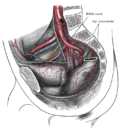| Asymptomatic inflammatory prostatitis | |
|---|---|
 | |
| Specialty | Urology |
Asymptomatic inflammatory prostatitis is a painless inflammation of the prostate gland where there is no evidence of infection. [1] It should be distinguished from the other categories of prostatitis characterised by either pelvic pain or evidence of infection, such as chronic bacterial prostatitis, acute bacterial prostatitis and chronic pelvic pain syndrome (CPPS). [2] It is a common finding in men with benign prostatic hyperplasia. [3]


